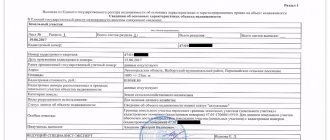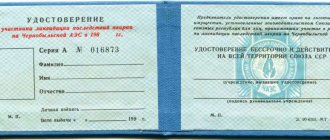Home / Real estate / Land / Provision / For purposes related to construction
Back
Published: 01/05/2017
Reading time: 13 min
0
1977
The procedure for obtaining ownership of a land plot largely depends on the category of land, the intended purpose of this land and the citizen wishing to receive the plot.
There are certain advantages of owning land plots for personal subsidiary plots (LPH) over owning plots of other categories of land use, but obtaining such plots into ownership and the rules for owning them have a number of features and restrictions.
- General information about private plots Types of private plots
- Requirements for sites
What is personal subsidiary farming?
Private household plots are one of the forms of conducting non-entrepreneurial activities for cultivating land to obtain products for personal consumption. According to the law (Federal Law No. 112 of July 7, 2003), private household plots are classified as non-profit activities if members of the same family are employed in it.
Attention! You can open a private plot on agricultural land by renting or purchasing a plot of land. From this moment on, you can safely engage in gardening, cattle breeding, etc. Private household plots are not subject to registration.
The permissible size of a land plot for running a personal subsidiary plot (maximum and minimum area) for this type of activity is determined by the standards of the administration of the village or district.
By virtue of Law No. 119-FZ dated 01.05.2016 (with amendments and additions that entered into force on 01.01.2017) “On the specifics of providing citizens with land plots that are in state or municipal ownership and located on the territories of the constituent entities of the Russian Federation that are part of Far Eastern Federal District, and on amendments to certain legislative acts of the Russian Federation", the above-mentioned limits on the size of plots for private household plots do not apply in cases of provision of plots in the territories:
- Republic of Sakha (Yakutia).
- Kamchatka region.
- Primorsky Krai.
- Khabarovsk Territory.
- Amur region.
- Magadan region.
- Sakhalin region.
- Jewish Autonomous Region.
- Chukotka Autonomous Okrug.
The activities of private household plots have a number of features , including:
- free from requirements for individual entrepreneurs;
- does not require reporting;
- at the output of private household plots, products are obtained to satisfy their own needs and, if desired, the surplus can be put up for sale.
To receive land as a private plot, you must submit an application to the administration, indicating your personal passport details and information about the plot (area, grounds for ownership). After approval, it will be possible to obtain a site diagram from the design organization.
The transfer of ownership begins with a resolution of the head of the district administration . Then the cadastral chamber assigns a number to the plot and draws up a plan. Based on these and documents already in hand, the executive committee confirms ownership. Its registration takes place at the regional registration chamber.
After this, the owner has every right to engage in activities:
- Grow crops.
- Maintain an apiary.
- Install greenhouses of any size.
- Raise animals and poultry.
How to obtain municipal land for private household plots
Pay attention to paragraph 4 of Article 28 - it emphasizes that it is not permitted to refuse to provide ownership of land plots in state or municipal ownership to citizens and legal entities for construction, except for cases specifically specified in the Land Code. There are only three such cases
How can they? The answer is “We don’t have land in the village” and that’s all. There is an agricultural company that most likely illegally occupied all the municipal lands, well, of course, not without the knowledge of the village council. The fact is that we have no young people at all, only old people aged 60-80 years, this is exactly how they answered me when I tried to purchase land. The most interesting thing is that there is a house, but no land. What does it mean. In our district, the allotment is 2 hectares, and in neighboring Ukholovsky for some reason up to 10 hectares per person. The region is one, but the laws are different. What can you do on 2 hectares if you deal with cattle? You can’t prove anything to anyone. So I’m going to contact the district agricultural department.
We recommend reading: Assignment of the right of claim by a decision that has not entered into legal force
Rights and obligations of the owner
Owners of private household plots have the following rights:
- Inherit and bequeath.
- Create an individual entrepreneur and register other legal entities.
- Make transactions that do not contradict the law.
- Have property and personal non-property rights.
- Erect houses, buildings, structures, structures (within the framework of the law on this type of economy). You can find out more about what is possible to build on the lands of private household plots and for the construction of which objects a permit is required here.
- Fence the area to prevent third parties from entering it.
Responsibilities:
- Do not cause damage to the earth and the surrounding nature.
- Make payments on time and in full.
- Maintain real estate on the site in accordance with architectural, planning, construction, environmental, sanitary and hygienic, fire safety and other established requirements, norms, rules, regulations.
- Use the land plot for its intended purpose for 3 years.
Veterinary, sanitary and other standards for content
Birds
Veterinary rules for keeping poultry were approved by order of the Ministry of Agriculture of the Russian Federation dated April 3, 2006 No. 103.
Different types of poultry should be housed in different areas of the building . Walking areas for different types of birds should be individual. Made from materials that can withstand cleaning and disinfection. Floors must be durable, durable and made from materials that are resistant to constant drainage and disinfectants. Ventilation must be provided to create an optimal microclimate in the premises for birds.
Veterinary and sanitary procedures:
- The premises must be washed regularly, and equipment (feeders, perches, drinking bowls) must be disinfected.
- The bedding material in the premises should consist of sawdust, wood shavings, etc. The use of frozen, moldy, or damp bedding material is prohibited. It is usually laid on a layer of lime - fluff 10-15 cm thick.
- Windows and doors are equipped with frames with mesh to prevent wild birds from entering the premises.
- It is recommended to work with poultry in clean overalls and shoes.
Pigs
Veterinary rules for keeping pigs were approved by order of the Ministry of Agriculture of the Russian Federation dated March 29, 2021 No. 114.
- It is necessary to provide the area with a fence to prevent other animals from entering. With a livestock of 5 heads, the minimum distance from the corner of the pig-breeding premises to the border of the neighboring plot should be at least 10 meters, with 15 heads - at least 40. For a certain type of pig, it is necessary to provide a certain area m2.
- Disinsection, decontamination and deratization of pig-breeding premises are carried out at least once a year.
- Feed must be heat treated for at least 30 minutes after boiling.
- Drinking water must be used as food for animals.
- Pigs kept on farms are subject to diagnostic tests, vaccinations and treatments against infectious diseases in accordance with the Epizootic Action Plan.
Cattle
The rules for keeping cattle are regulated by order of the Ministry of Agriculture of the Russian Federation dated December 13, 2021 No. 551.
- The food must meet veterinary requirements. The stock of feed should be kept in the amount required for each head for 30 days in advance. Milk – for 1 day. Powdered milk - for at least 15 days.
- Hay, straw, silage, etc. – for 1 stall period.
- For drinking, you must use clean drinking water.
- Pastures must be located at least 2.5 km away. from a watering hole.
- Cattle must be housed in sections or stalls. The sections must be arranged in such a way as to ensure unhindered exit from them. Different types of cattle need to be kept in different rooms (of the same or different buildings).
Legal sale of products
According to the Federal Law on Personal Subsidiary Farms, the sale of products produced on the lands of private household plots does not relate to entrepreneurial activity.
You can sell your products grown on the site in markets , as well as by concluding a cooperation agreement with restaurants, cafes and other catering establishments. But to do this, it must undergo a certain examination for compliance with standards, and with ready-made documents and certificates in hand, the owner of the product can sell it for use by other people.
- documents confirming compliance with the mandatory requirements of regulatory documents (copies of the certificate or declaration of conformity);
- veterinary accompanying documents: veterinary certificate form No. 2 (for transportation from another region (city);
- veterinary certificate form No. 4 or a stamp of the state veterinary service in the shipping document (for transportation within the district (city);
- for meat, in addition to the above: the conclusion of the state laboratory of veterinary and sanitary examination, allowing the sale of meat on the market.
To protect yourself from the persistent attention of the Tax Service, you need to obtain a document from the local administration stating that this particular product was produced in this particular area. Next, it is advisable to register the private household plot in the household register.
To do this, indicate:
- Full name, date of birth of the owner of the land plot, as well as the full name of all family members living with him.
- Number of animals, bees or birds present.
- The area of land occupied by crops or plantings.
- the number of units of agricultural machinery and vehicles involved in the processing and creation of products.
You can find out more about how to open a private household plot and what taxes the owner expects here.
How to take land for private plots
Personal farming is one of the methods of agricultural production and is used to produce various food products. This includes not only growing seasonal vegetables and fruits, but also raising livestock. And all products belong exclusively to the owner of the subsidiary farm, who can dispose of it at his own discretion. In this article we will talk about how to take and register ownership of land for private household plots.
If you want to find out how to solve your specific problem, please contact the online consultant form on the right. It's fast and free! Or call us at 8(800)-350-30-02 (the call is free for all regions of Russia)!
When is it possible to register ownership of land for private plots?
It is not difficult to use the land as a subsidiary plot. It is enough to have ownership of a certain plot of land and all structures located on the territory. Legislation divides personal farm land into household plots and field plots. Household land is most often used for farming with the right to construct all necessary structures, while field plots are not intended for the construction of any buildings.
The Federal Law “On Personal Subsidiary Farming” states that a land plot has the status of a personal subsidiary plot if:
- the land has all the title documents indicating the type of use of the land;
- subsidiary farming is constantly carried out on it;
- the owner has registration in a rural area.
Only capable citizens who have inherited or purchased a plot of land can run such a private plot. The state often provides land plots for this activity, but most often only to those citizens who are registered in rural settlements. It happens that a city dweller can easily obtain land for subsidiary farming from the municipal authorities. This is only possible if there is a sufficient number of free plots of land. The entire area of land plots on which subsidiary farming is carried out by one owner should not exceed 0.5 hectares.
But if the documents simply indicate that this land is used for gardening or livestock farming, this does not give it the necessary status. You also need to be on the list to receive government assistance. To do this, all documents of the owner of a personal subsidiary plot are checked by the local administration. For verification, you must provide an identification document, a certificate of ownership (copy) and the original title documents.
To run a private farm you will need the following property:
- land plot;
- residential, household and industrial buildings;
- livestock and poultry;
- agricultural equipment, machinery and various implements.
The law allows you to breed and raise any poultry, livestock, bees, as well as grow berries, fruits and vegetables. But there are also exceptions, for example, in order to keep exotic animals, you will have to pay the appropriate tax.
How to register land for private plots as ownership
First of all, you need to collect all the documents. To register land for personal farming, you should contact the local administration and land committee. If you are adding a house or cottage to your property, you will need:
- passport for home ownership;
- land documents;
- certificate of state registration.
Documents for home ownership in the purchase and sale agreement are attached to the agreement itself and are re-registered to the new owner within a month. Passports must also be issued for additional extensions. In addition, the owner is required to have a plan of his home, and of all premises without exception, along with rooms.
Next, you need to undergo state registration. No separate licenses are required to run a subsidiary farm. Land ownership is sufficient. This activity is not considered entrepreneurial by law, even if all the products are sold. The state does not collect taxes on such sales.
There is also a special accounting of personal holdings. They are kept in the so-called household books, indicating the following details:
- Full name of the owner of the land plot, as well as his family members;
- area of the entire land;
- number of heads of livestock and poultry;
- list of agricultural equipment and machinery.
You should know that if the owner of such a subsidiary farm decides to sell his products, it is better for him to obtain the appropriate certificate in advance. This paper will allow you not only to transport any quantity of products for sale without inconvenience, but also to hand them over in bulk to enterprises. At the same time, by presenting a document stating that everything was produced in a personal household, the owner is exempt from all taxes.
Is it possible to register on these lands?
The construction of buildings and registration in a house erected on the lands of private household plots falling under the category of urban settlements is possible. If the land belongs to the category of agricultural or field land, then no. The construction of residential buildings and registration in them are excluded according to the law “On personal subsidiary plots”, Article 4.
Important! Housing is recognized as suitable for registration and residence only after the project is put into operation and registered in the state register.
Before applying for registration in the house, you must prepare a package of documents :
- Application with a request to register a citizen.
- Citizen identification documents.
- House book or extract from it.
- Consent of the property owner.
- Registration certificate of the house.
- Title documents for the house.
- Power of attorney (if it is impossible for a citizen to appear in person).
To run a farm, registration on private household plot lands is not required.
How to register land for private plots as ownership
How to register ownership of land for private plots? This question is asked by many agricultural production owners. All products obtained from the land belong to the owner, but the land may be leased or used indefinitely, which negatively affects the cost of sales and the impossibility of carrying out legal transactions (purchase and sale, donation). We’ll talk further about how land is registered for personal subsidiary plots.
When can you register ownership of land for private plots?
Each land plot is assigned a category of intended use. Land for personal farming is divided into household plots and field plots. The first is suitable for planting plants and can be used in the construction of buildings. The second is intended exclusively for agricultural needs, including not only planting crops, but also raising animals. The owner of land for private plots could receive it as an inheritance or free of charge, through the distribution of land by a village or city council. The owner must have title documents with a clear definition of the category. In most cases, they indicate farming.
To register such land it must be located:
- Domestic buildings.
- Equipment or machines for agricultural needs.
- Livestock and poultry.
Plants must also grow on the ground. Thus, registration of land for private household plots implies the actual conduct of activities by the owner. Only in this case is it possible to register it.
How does the registration of land for private plots into ownership take place?
Before proceeding with the registration of ownership of land for private household plots, its owner needs to collect documents.
These include:
- Copies of passports of all owners.
- Copies of documents certifying the right to use land.
- Copies of documents for buildings located on the site.
- Land survey plan.
- Cadastral passport.
As a rule, land owners have documents on state registration of buildings. All buildings must be erected with prior approval from the local administration and registered with Rosreestr. Otherwise, the owner will have to deal with this procedure separately.
You can order the document from any licensed geodetic company by providing title documents for the land. A team of surveyors led by engineers will take measurements of the site. Upon completion, the results are entered into an act signed by the owner of the land and the neighbors of adjacent plots. In about a few weeks, the survey plan will be handed over to the owner. Carrying out this procedure will require significant expenses.
The cadastral passport is issued on the basis of the information specified in the land survey plan. You can apply for it to Rosreestr or the Cadastral Chamber. The document will require a wait of several weeks. The owner will need to pay a small government fee. In the process of creating a cadastral passport , the land for private household plots is assigned a unique number. It is an identifier that allows you to find general data about the site on the websites of Rosreestr and State Services.
It is necessary to apply with documents to the local administration or land committee to obtain permission to register the land for private plots as ownership. This will require writing an application requesting the alienation of the entrusted plot from the property of the municipality and its transfer to private hands. As a rule, there are no problems with obtaining permission.
Registration of ownership of land for private plots
The last stage on the path to registering land for private household plots as ownership is submitting documents to Rosreestr. Here the owner will need to pay a state fee of 2 thousand rubles. An identical list of documents specified in the previous section is submitted to Rosreestr, including a resolution with permission to register property rights obtained from the local administration or land committee. Rosreestr will also need to fill out an application in the form established at the state level.
It must indicate:
- Applicant's passport details.
- Cadastral number of the plot.
- List of title documents.
- Category of land.
- Presence of encumbrances.
Registration of new documents will take at least two weeks. During this period, Rosreestr employees check the data specified in the application and documents for accuracy. If errors are found or information is falsified, it is possible to receive a refusal.
Conclusion. You can register ownership of land for private plots by contacting Rosreestr. This procedure will require additional preparation of documents, including drawing up a land survey plan and a cadastral passport. Without them, registration will not be possible.
How to get loans?
Like any business, running private household plots requires serious financial costs : purchasing equipment, constructing premises, purchasing animals for breeding, etc. There may not be any free finance available to a citizen. In this case, the bank can come to the rescue. In order to receive a loan, the following conditions must be met: the client must be a citizen of the Russian Federation and already own the land plot on which the farm is run.
To draw up a contract you need:
- citizen's identity document;
- questionnaire and application;
- extracting their household register;
- military ID (for men under 27 years old);
- documents confirming employment and solvency;
- documents on the security provided (collateral);
- invoices, checks, payment documents indicating the intended use of the funds received (payment for services, purchase of goods, equipment, livestock, etc.).
The loan is given for a period of 2 to 5 years.
Pension insurance
Article 9 of Federal Law No. 112-FZ dated 07/07/2003 grants citizens with the right to voluntarily enter into legal relations for compulsory pension insurance in accordance with the legislation of the Russian Federation.
Since January 2013, amendments to Article 29 of Federal Law No. 167 “On Compulsory Pension Insurance in the Russian Federation” came into force on the right of owners of private household plots to make contributions to the Pension Fund of at least 150 rubles per month. This will allow you not to be left without a pension when the time comes. It will be unfair: a person works by the sweat of his brow in agriculture, the state does not know about this, and by the time the person is left without support due to old age. The above-mentioned law allows you to avoid such situations.
LPH - what is it?
LPH stands for “land for personal subsidiary plots.”
Subsistence farming is one of the options, which is a non-entrepreneurial type of activity (that is, not implying income from the goods received), aimed at partially or fully satisfying the needs of citizens for agricultural products.
Here it should immediately be clarified that citizens running such businesses have every right to sell their products, and at the same time they are exempt from paying taxes. The only condition that in this case must be strictly observed is that all work performed on the site must be carried out either by its direct owner or members of his family.
The use of hired labor in private household plots should be categorically excluded (because in this case it already becomes a business activity).

Is it possible to build on a plot for private farming?
On agricultural lands, only buildings intended for seasonal use or technical buildings necessary for conducting economic activities can be erected. Capital constructions are possible only when conducting farming activities .
Attention! The lands of settlements on which it is possible to establish individual housing construction or private subsidiary plots are suitable by law for the construction of residential buildings of no more than 3 floors with the possibility of subsequent registration in them.
You can read more about whether it is possible to build a house on the lands of private household plots and what is needed for this here.









